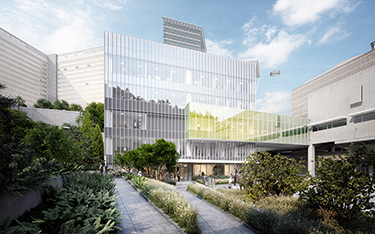|
Subscribe / Renew |
|
|
Contact Us |
|
| ► Subscribe to our Free Weekly Newsletter | |
| home | Welcome, sign in or click here to subscribe. | login |
Construction
| |
 |
February 27, 2020
Here’s what’s in store for health care in the Northwest
Skanska USA Building

Williamson
|

Howell
|
There’s one thing we know about the future of construction in health care, which is not exclusive to the Northwest: The U.S. population is aging and demand for acute care is increasing.
With it, the nature of health care is evolving, so planning, development and building health facilities must likewise change. As we forecast the future of health care design and building, we know three principles must drive health care’s built environment: Build for patients, build for efficiency and build for outcomes.
Those are tall orders, but our owner-partners expect this of us.
Trends in play
For more than a decade, the steadily accelerating pace of health care-related construction starts has continued. Early on, some Pacific Northwest industry watchers pegged this growth to the slight increases in hospital margins due to Oregon’s and Washington’s status as Medicaid expansion states under the Patient Protection and Affordable Care Act, passed by Congress in 2010.
Overall, expanded dollar-for-dollar Medicaid reimbursement dollars helped reduce rates of uncompensated care. This positively impacted the financial margins of regional hospitals, medical centers, federally qualified health centers, clinics and providers.
Additionally, Medicaid and Medicare reimbursements grew for care in prevention and outpatient settings. And the parallel growth in commercial health insurance coverage rates also contributed to more investment in the modernization and construction of health facilities.
Fast forward to a decade later, building pace remains unabated here in the Northwest. Oregon and Southwest Washington have experienced a very active health care construction market with a new maternity/obstetric wing to a new hospital in Vancouver, substantial expansion of more than five large buildings on a new medical campus at Portland’s South Waterfront, two brand new critical access hospitals in Oregon’s northern coastal communities, a new mental health inpatient facility in Portland, extensive expansion of new acute inpatient space in Central Oregon and more.
Since 2010, the Washington market has seen a number of new acute towers started, completed and others in design and planning phases to support the growing population, as well as fulfilling commitments made during health care systems’ mergers and acquisitions.
In the past several years, many of those projects included space to support the need for more inpatient beds. Many of the Puget Sound region’s health care systems continue to update diagnostic and radiology treatment areas to support newer, more advanced technology and growing demands.
Outpatient medical office and ambulatory surgery centers continue to expand rapidly to serve the growing outpatient service lines. In addition, a number of new behavioral health facilities were constructed and several larger inpatient facilities are on the drawing boards to meet the market demand.
And active planning is underway in the Northwest for more long-established health care systems to get much needed infrastructure updates, new clinics and outpatient facilities, new hospital wings, aging facilities and even full replacements to manage the ever-increasing complexity of care needed by patients.
Other previously predicted trends are still in play. One is the drive to make care more geographically accessible. Clinics and micro-hospitals, funded by larger health care systems, continue to increase in number and spread, under the notion of bringing health care to the person/community, instead of assuming the person will be able to locate a larger centralized care location.
These trends are clearly seen in the Pacific Northwest. We are seeing the focus on wellness and preventive care in outpatient/clinic facilities in many communities as the vehicle to take health care to the people, yet still relying on some centralized inpatient facilities for higher-acuity patients.
Emerging examples
Health care strategic planners now can virtually walk in the path of the patient to examine service/care delivery and flow. The concept of the “neighborhoods of care” at the St. Charles Medical Center’s new patient tower and ICU in Bend, Oregon, was first planned as a “cardboard city.”
In an off-site warehouse, care providers and hospital employees modeled how reconfiguring patient rooms could simultaneously accommodate overlapping care providers, visiting family members, lifting equipment and multiple bio-monitor units. In the “neighborhood,” several micro-stations exist throughout the unit for charting, professional consultation, medication dispensing and remote patient monitoring.
The initial structure of the nursing station in the inpatient behavioral health unit at the PeaceHealth Sacred Heart Hospital in Eugene, Oregon, was reconfigured early in the planning process because the centralized station didn’t afford a full visual spectrum of patients in their rooms. Providers found when they can make eye contact with patients, better and more timely assessments can happen and safety is improved.
At Oregon Health & Science University, a new wing of the Casey Eye Institute is being constructed to expand space for clinical and applied research, so the research can done in partnership with direct patient care, connecting leading edge treatments seamlessly in time and space to the ophthalmology patients who need them.
For many health systems, community-based care is a strategic focus, bringing health care to the people. Patients are getting more engaged and empowered in this age of information and rise of consumerism.
Patients are expecting more choice and more access to data to inform their decision making. With services such as telehealth, patients can meet with their doctors via an internet connection at their own kitchen counter instead of an exam room.
And the broad-based information technology adoption by health care providers, such as practice management and electronic medical record systems, are driving facilities to implement extensive data connection requirements. These factors are driving the design more than ever of new hospitals, clinics and health facilities.
The original patient floors at the MultiCare Good Samaritan Hospital in Puyallup were configured with centralized nursing stations. When they elected to build out the remaining two floors, they utilized cardboard and virtual mock-ups so that the care teams were able to confirm improved patient visibility by the nursing staff through decentralized nursing stations. This approach brought the staff closer to the patients and increased one-on-one time with the patients by reducing time between charting, nutrition, medication and the patient’s bedside.
The health care ecosystem continues to expand its reach into the communities through urgent care clinics and freestanding medical office buildings. Kaiser Permanente also is growing rapidly as they continue to expand their services in the Northwest.
We continue to see clinics moving to an “onstage and backstage” program. This approach groups the providers in “backstage,” open-environment teaming areas to create more collaboration between doctors and nursing staff.
Double-sided exam pods then allow patients and their families access from the public corridors and the care providers to enter from the backstage, creating more efficient flow and less travel time between the nursing areas and exam rooms.
Focusing on outcomes ?
Building for outcomes is perhaps the most critical function for which we plan and prepare. In the array of potential acute, outpatient and ambulatory settings, we work with our clients to create flexible environments that anticipate changing needs of patients.
We work to customize and align the design goals to create the desired outcomes and to facilitate the environment of safety and healing. The best project outcomes occur when the design and construction team work collaboratively with the providers and users.
Sustainability is also an important element in health care construction not only to be environmentally responsible but also to reduce operating costs, including building for environmental resiliency. Similarly, creating sustainable structures can lead to the efficient use of resources since health care facilities require large amounts of energy and resources to run multiple systems. Reducing operating costs can be a significant positive impact to the financial health of a hospital.
To build for efficiency, Samaritan North Lincoln Hospital in Lincoln City, Oregon, made smart use of tall windows to maximize light and reduce electricity needs, and implemented efficient mechanical systems designed to save operating costs. Samaritan North Lincoln also sought to build for the future by creating a hospital that would grow with the community, anticipating future health needs such as expanded birthing and obstetric triage rooms, larger and better-configured emergency and trauma care services, and modernized acute patient care space.
After completing the first LEED Gold hospital in Washington in 2010, we continue to see increased interest in carbon reduction, and more sustainable solutions on health care projects.
It only makes sense that more emphasis is taken to reduce new hospitals’ Energy Use Intensity (EUI), as they are 24/7 facilities and large consumers of energy.
Several years ago, Target 100 challenged new hospitals to achieve an EUI of 100 or less. Many of the newer facilities are getting close through utilization of daylighting, lighting controls, heat recovery, more efficient equipment, advanced system monitoring and automation controls, and improved building envelopes.
In addition, there is more emphasis on right-sizing patient rooms, exam rooms and procedural spaces to ensure patient care and procedures are performed efficiently while minimizing wasted space. More focus is placed on standardization and streamlining patient care to increase efficiencies and reduce errors. These efforts can improve patient outcomes. More health care organizations are embracing lean principles like Virginia Mason Hospital and Seattle Medical Center has done for years to improve procedural outcomes, improve predictability and reduce cost.
Today’s hospitals, clinics and health care spaces must be built with the focus on evolving and increasingly complex patient care. This well illustrates the ongoing and strong interest in redesigning facilities with flexibility, cost efficiencies and provider engagement in mind.
John Williamson is manager of Central Oregon, and Mark Howell is senior vice president and account manager in Seattle for Skanska USA Building.
Other Stories:
- Hospital projects in rural areas face extra obstacles
- UW’s new health sciences building will be a hub for 21st-century care
- Good design takes some stress out of visiting the hospital
- Building out this new hybrid OR was no simple operation
- Fire dampers: one more way hospitals can save lives
- Hospitals giving way to other care options as providers look to cut costs
- CHP systems: a powerful energy-saving tool for hospitals
- A look inside the Cure Factory, Seattle Children’s new cell therapy lab
- Health care could look a lot different in 2040, so get ready
- Integrated project delivery offers risks and rewards for team members
- How welcoming design can improve outcomes for patients — and staff



